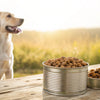How Much Canned Food Should My Dog Eat? A Comprehensive Guide for Pet Owners
- Houndsy
Table of Contents
- Introduction
- Understanding Your Dog's Nutritional Needs
- How Much Canned Food Should My Dog Eat?
- Special Considerations for Feeding Canned Food
- The Importance of Quality
- Common Feeding Mistakes to Avoid
- Conclusion
- FAQ
Introduction
Did you know that approximately 59% of dogs in the United States are classified as overweight or obese? This alarming statistic highlights a critical aspect of dog ownership: feeding our furry friends the right amounts of food is essential for their health and well-being. If you're a dog parent, you may have found yourself wondering, "How much canned food should my dog eat?" This question is vital, as the correct portion size can prevent obesity and nutritional deficiencies, ensuring our beloved companions lead happy, healthy lives.
In this comprehensive guide, we will delve into the fundamentals of dog nutrition, focusing specifically on canned food. You'll learn about factors influencing your dog's dietary needs, how to determine the right amount of food, and best practices for feeding your canine companion. By the end of this post, you'll have a clearer understanding of your dog's unique nutritional requirements and how to meet them effectively.
So, let's get started! We invite you to reflect on your own feeding routine—are you providing the right portions for your dog? Understanding the specifics of your dog's dietary needs can empower you to make informed decisions about their meals.
Understanding Your Dog's Nutritional Needs
Before we can determine how much canned food your dog should eat, we need to understand the factors that influence their nutritional needs.
Age
Puppies, adults, and senior dogs all have different nutritional requirements. Puppies require more calories and nutrients to support their rapid growth and development. Adult dogs typically have more stable needs, while senior dogs often require fewer calories due to decreased activity levels.
Size and Breed
The size and breed of your dog can significantly affect their caloric needs. Larger breeds generally require more food than smaller breeds. Additionally, certain breeds may have specific dietary needs or restrictions.
Activity Level
A dog's activity level directly impacts their caloric requirements. An active dog will need more food to sustain their energy levels than a more sedentary dog.
Health Status
Health conditions can affect how much food your dog should eat. For example, a dog recovering from surgery may require a different diet than a dog with chronic conditions like diabetes or kidney disease.
Body Condition Score
Assessing your dog's body condition score (BCS) can help you determine if they are at a healthy weight. A score of 4-5 out of 9 is ideal for most dogs. Dogs that are overweight may need a reduced caloric intake, while underweight dogs may need additional food.
How Much Canned Food Should My Dog Eat?
Determining how much canned food your dog should eat involves several steps. Generally, the best place to start is with the feeding guidelines provided on the packaging of the canned food. These guidelines offer a good starting point based on your dog's weight.
Step-by-Step Guide
-
Check the Can: Most canned dog food will have a feeding chart on the label that provides recommendations based on your dog’s weight.
-
Calculate Daily Requirements: Based on the feeding chart, calculate the total daily amount of food your dog should receive.
-
Divide Meals: Most dogs do better when fed multiple smaller meals throughout the day rather than one large meal. Depending on your dog’s size and age, aim for 2-4 meals per day.
-
Monitor Your Dog: Keep an eye on your dog’s weight and overall health. Adjust the portion sizes as needed, especially if you notice changes in their body condition score.
Example Feeding Guidelines
To give you an idea of how these calculations work, here’s a hypothetical example:
- Dog Weight: 30 lbs
- Canned Food Recommendation: 1 can (12.5 oz) per day, as per the feeding chart.
In this case, if you divide the daily amount into two meals, you would feed your dog half a can (6.25 oz) for each meal.
Special Considerations for Feeding Canned Food
When feeding canned food, there are a few additional considerations to keep in mind.
Mixing with Dry Food
Many pet owners choose to mix canned food with dry kibble for added flavor and nutrition. If you opt for this approach, remember that one can of wet food generally replaces a portion of dry food. For instance, one 12.5 oz can may replace around 1 to 1.5 cups of dry kibble. Adjust the quantities accordingly to prevent overfeeding.
Hydration Needs
Canned food has a higher moisture content than dry kibble, which can help keep your dog hydrated. However, always ensure that fresh water is available to your dog throughout the day.
Transitioning Between Foods
If you're transitioning your dog from dry food to canned food (or vice versa), do so gradually over a week to avoid digestive upset. Start by mixing a small amount of the new food with the old, gradually increasing the new food while decreasing the old.
The Importance of Quality
Not all canned dog food is created equal. As responsible pet owners, we should prioritize high-quality, nutrient-dense options. Look for brands that use whole ingredients and avoid fillers, artificial preservatives, and by-products. Understanding what's in your dog's food can help you make the best choices for their health.
At Houndsy, we are committed to enhancing the feeding experience for dogs and their owners. Our Houndsy Kibble Dispenser is designed to simplify portion control and conveniently deliver the right amount of food without the mess associated with traditional feeding methods. The dispenser's sleek mid-century modern design complements your home decor while ensuring your dog receives the right portions every time. Explore the Houndsy Kibble Dispenser here.
Common Feeding Mistakes to Avoid
As dog owners, we all want the best for our pets. However, there are common feeding pitfalls that can lead to health problems.
Overfeeding
One of the most prevalent issues is overfeeding, often stemming from the desire to please our dogs. Overfeeding leads to obesity, which is associated with various health issues.
Underfeeding
Conversely, underfeeding can lead to nutritional deficiencies. It's crucial to find a balance that meets your dog's needs.
Ignoring the Feeding Guidelines
Feeding without consulting the guidelines can lead to inconsistencies. Always refer to the food packaging to ensure you're meeting the recommended amounts.
Conclusion
Feeding your dog the right amount of canned food is crucial for their health and happiness. By considering factors such as age, size, activity level, and body condition, you can make informed decisions about their diet. Remember to refer to the feeding guidelines on the packaging and adjust portions based on your dog's unique needs.
As you reflect on your dog's feeding routine, consider how the Houndsy Kibble Dispenser can simplify your life. With its innovative design and perfect portion control, it allows you to provide your dog with the nutrition they deserve while enhancing your home decor. Learn more about the Houndsy Kibble Dispenser here.
FAQ
1. How much canned food should I feed my dog?
The amount varies based on your dog's weight, age, and activity level. Always refer to the feeding guidelines on the canned food packaging for accurate recommendations.
2. Can I mix canned and dry food?
Yes, many pet owners mix canned food with dry kibble for added flavor and texture. Just ensure you adjust the quantities to avoid overfeeding.
3. How often should I feed my dog?
Most adult dogs do well with two meals per day, while puppies may require three to four smaller meals.
4. What if my dog is overweight?
If your dog is overweight, consult your veterinarian for personalized advice and consider adjusting their portion sizes or switching to a weight management diet.
5. How do I transition my dog to a new food?
Gradually mix the new food with the old over a week, increasing the new food while decreasing the old to avoid digestive upset.
By understanding your dog's nutritional needs and utilizing our Houndsy Kibble Dispenser, you can create a feeding experience that is convenient, consistent, and visually appealing. Let's prioritize our pets' health and happiness together!












